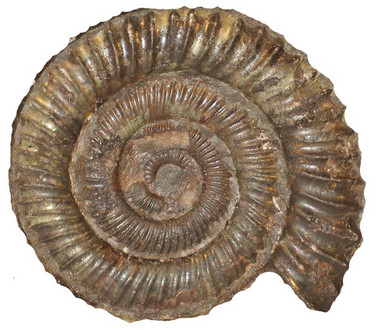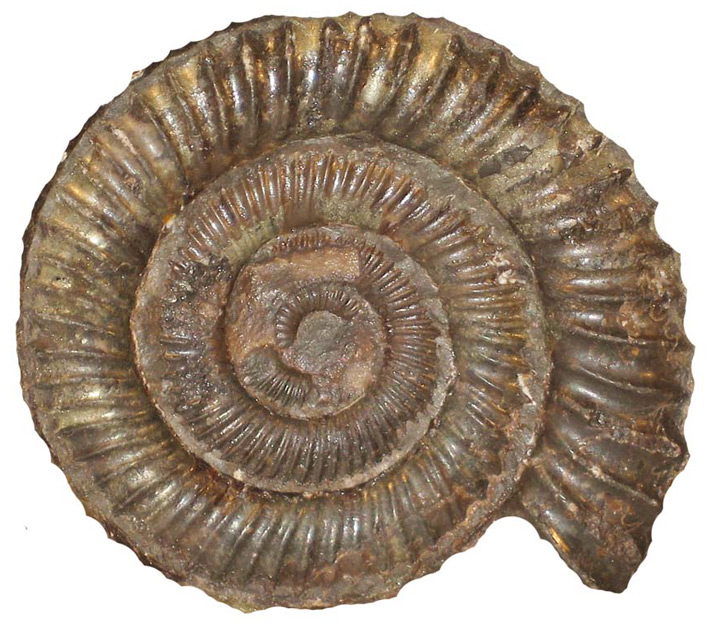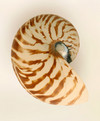Ammonite Fossil
Ammonites were molluscs, which swam in the ancient oceans millions of years ago, at the same time as the dinosaurs walked on the earth. Like the dinosaurs ammonites are now extinct, but they are related to octopus, squid and cuttlefish in the cephalopod family. You have probably seen, or even eaten these creatures? Ammonites are also similar in shape and form to the nautilus (see the Collections Connections link below). What you see here is just the fossilized remains of the ammonite’s shell. The fossil is polished shiny smooth and the spiral is punctuated with distinctive ribs showing the growth chambers of the shell. The ammonite is very old (between 400 and 65 million years old) and you can see that the inner part of the spiral has worn away.
Because ammonites are extinct we know very little about their way of life. The soft bodies rotted away when the creature died, leaving only their spiral shells to become fossilized. From the fossils we know that ammonites varied in size from 2cm to 2m in diameter. The creature would have lived in the last and largest of the spiral chambers on the outside edge. The other chambers were partitioned off and filled with gas. By controlling the amount of gas in the chambers the ammonite could control whether it floated or sank in the water.
Ammonites are found all over the world and their intricate spiral shape has made them rich in symbolism. The name was inspired by the spiral shape which resembles rams’ horns. The Roman historian Pliny the Elder called the fossils “ammonis corunua” which means “horns of Ammon” after the Egyptian god Ammon or Amun who was usually represented with ram’s horns. In America, the Blackfoot tribe called ammonites buffalo stones because they look like sleeping bison.
In India, ammonites found in Nepal and northern India are called Saligrams. They are considered the direct symbol of Lord Vishnu, as one of Vishnu's avatars (incarnations) was stone (Sri Saligram). The stones are kept in temples, monasteries and households as natural symbols of Vishnu and water in which they have been bathed is drunk daily. In addition, saligrams are used in marriages, funerals and house-warmings. If a dying person sips water in which a saligram has been steeped, it is believed that they will be freed from all sins and will reach the heavenly abode of Vishnu.
In the Western Isles, Scotland, ammonites are known as crampstones and were once used to cure the cramp in cows, using by soaking the fossils in water and using that to wash the cow.

Diameter:10cm

Diameter:10cm

Ammonites were molluscs, which swam in the ancient oceans millions of years ago, at the same time as the dinosaurs walked on the earth. Like the dinosaurs ammonites are now extinct, but they are related to octopus, squid and cuttlefish in the cephalopod family. You have probably seen, or even eaten these creatures? Ammonites are also similar in shape and form to the nautilus (see the Collections Connections link below). What you see here is just the fossilized remains of the ammonite’s shell. The fossil is polished shiny smooth and the spiral is punctuated with distinctive ribs showing the growth chambers of the shell. The ammonite is very old (between 400 and 65 million years old) and you can see that the inner part of the spiral has worn away.
Because ammonites are extinct we know very little about their way of life. The soft bodies rotted away when the creature died, leaving only their spiral shells to become fossilized. From the fossils we know that ammonites varied in size from 2cm to 2m in diameter. The creature would have lived in the last and largest of the spiral chambers on the outside edge. The other chambers were partitioned off and filled with gas. By controlling the amount of gas in the chambers the ammonite could control whether it floated or sank in the water.
Ammonites are found all over the world and their intricate spiral shape has made them rich in symbolism. The name was inspired by the spiral shape which resembles rams’ horns. The Roman historian Pliny the Elder called the fossils “ammonis corunua” which means “horns of Ammon” after the Egyptian god Ammon or Amun who was usually represented with ram’s horns. In America, the Blackfoot tribe called ammonites buffalo stones because they look like sleeping bison.
In India, ammonites found in Nepal and northern India are called Saligrams. They are considered the direct symbol of Lord Vishnu, as one of Vishnu's avatars (incarnations) was stone (Sri Saligram). The stones are kept in temples, monasteries and households as natural symbols of Vishnu and water in which they have been bathed is drunk daily. In addition, saligrams are used in marriages, funerals and house-warmings. If a dying person sips water in which a saligram has been steeped, it is believed that they will be freed from all sins and will reach the heavenly abode of Vishnu.
In the Western Isles, Scotland, ammonites are known as crampstones and were once used to cure the cramp in cows, using by soaking the fossils in water and using that to wash the cow.





















